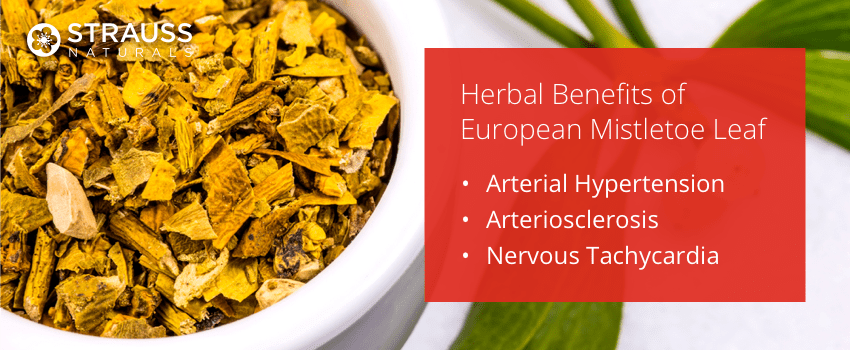
European Mistletoe Leaf Overview
European Mistletoe (Viscum album) is a plant that grows on various trees such as apple, oak, pine, and elm. European mistletoe is not the same as American mistletoe, which is often used as a holiday decoration. It is Traditionally recognized as specific for arterial hypertension and helpful also for arteriosclerosis and nervous tachycardia. Historically, the herb has been used in Europe for its cardiovascular properties, particularly its hypotensive and vasodilatory actions.
General information of European Mistletoe Leaf
While the berries and stem of European mistletoe are also used to make medicine, its leaves have traditionally been used in Herbal Medicine for mild hypertension and associated headaches, vertigo, and heart weakness.What is European Mistletoe Leaf used for?
Mistletoe is hypotensive, meaning it can help to lower blood pressure. "Mistletoe opens up circulation to areas that have been cut off from adequate blood supply by tension," writes David Hoffman, author of Medical Herbalism: The Science Principles and Practices of Herbal Medicine. "It reduces cardiovascular tension and blood pressure while bringing in new blood, blood sugar, and healing to areas long cut off, tensed up, weakened, or damaged." It is also used to help boost the immune system and increase the quality of life in those who are struggling with cancer treatments.
Uses & Effectiveness of European Mistletoe Leaf
Ever since Suzanne Somers announced on Larry King Live that she was using European mistletoe to treat her breast cancer, mainstream interest in the herb skyrocketed. Yet, mistletoe therapy had been utilized for centuries to treat cancer, dating as far back as the 1920s. However, there is no substantial proof in any clinical trial studies linked to cancer and European mistletoe. European mistletoe is also used for:- high blood pressure
- atherosclerosis
- internal bleeding
- hemorrhoids
- epilepsy
- gout
- depression
- sleep disorders
- headaches
- absence of menstrual periods
- symptoms of menopause
Precautions of European Mistletoe Leaf
Do not take European mistletoe leaf, and consult a doctor before use if you have:- An auto-immune disease
- Heart disease
- Leukemia
- Liver disease
- An upcoming organ transplant

Herbal Benefits of European Mistletoe Leaf
1) Arterial Hypertension
Renowned Herbalist Maria Treben has described European mistletoe as the best remedy for heart and circulatory complaints in her famed book, “Health Through God's Pharmacy: Advice and Proven Cures with Medicinal Herbs. Mistletoe has been found to upregulate the nitric oxide pathway. A lack of nitric oxide to the heart can lead to dangerous heart conditions, including heart failure. The herb is often used in Herbal Medicine for long-term therapy for mild high blood pressure and as a prophylactic of arteriosclerosis.2) Arteriosclerosis
Its ability to lower blood pressure helps prevent pressure on the cardiovascular system, which prevents the chances of shrinkage of the arteries. This action can help to prevent coronary heart disease and strokes. By lowering blood pressure, mistletoe extract can ease the strain and stress on the cardiovascular system and cut down on the impact of atherosclerosis.3) Nervous Tachycardia
While the use of mistletoe is Traditionally recognized specifically for arterial hypertension, it is also helpful for arteriosclerosis and nervous tachycardia. When one becomes anxious, their heart rate increases, often resulting in a rapid heart rate. Mistletoe is a nervine herb that strengthens and maintains the nervous system. Mistletoe appears to lower the stress hormone cortisol for anxiety, calming the nerves down to a more manageable level. Mistletoe has been used traditionally as a relaxant and herbal remedy for sleep for centuries. This herb's chemical components affect the release of neurotransmitters that calm down and soothe the nervous system, allowing for a night of healthy and restful sleep.FAQs
What Are the Side Effects of Mistletoe?
European mistletoe is safe when taken orally; however, ingesting large amounts (over 200 mg) can cause vomiting, diarrhea, cramping, and other side effects. Frequent, short-term use may cause liver damage. Before incorporating mistletoe into your routine, speak with your doctor. Do note take mistletoe if you are:- Pregnant
- Breast-feeding
- Living with an auto-immune disease
- Living with heart disease
- Undergoing treatment for leukemia
- Suffering from liver disease
- Undergoing an organ transplant
Is European Mistletoe Poisonous?
The species in Europe (Viscum album) is less toxic than the species native to America (Phoradendron serotinum). A study of 1754 American mistletoe exposures reported no deaths.How Do You Take European Mistletoe Leaf?
While the appropriate European mistletoe dose depends on age, health, and other conditions, European Mistletoe is often taken orally. However, in some parts of the world, European mistletoe injections are used to treat cancer and failing joints.How to make European Mistletoe Leaf tea?
- Boil one cup of water
- Add 1-2 teaspoons of dried European mistletoe herb
- Steep for 5-10 minutes

